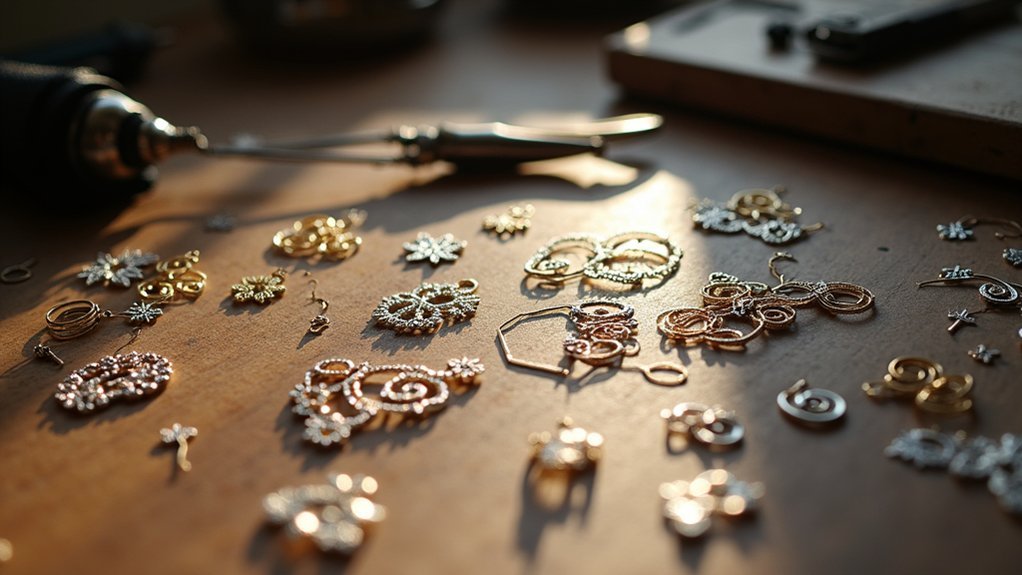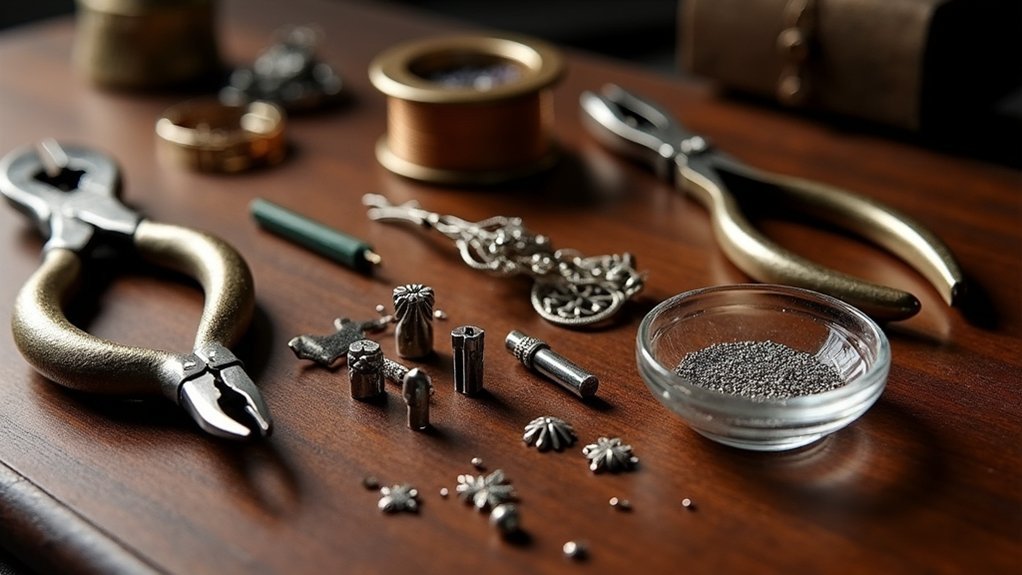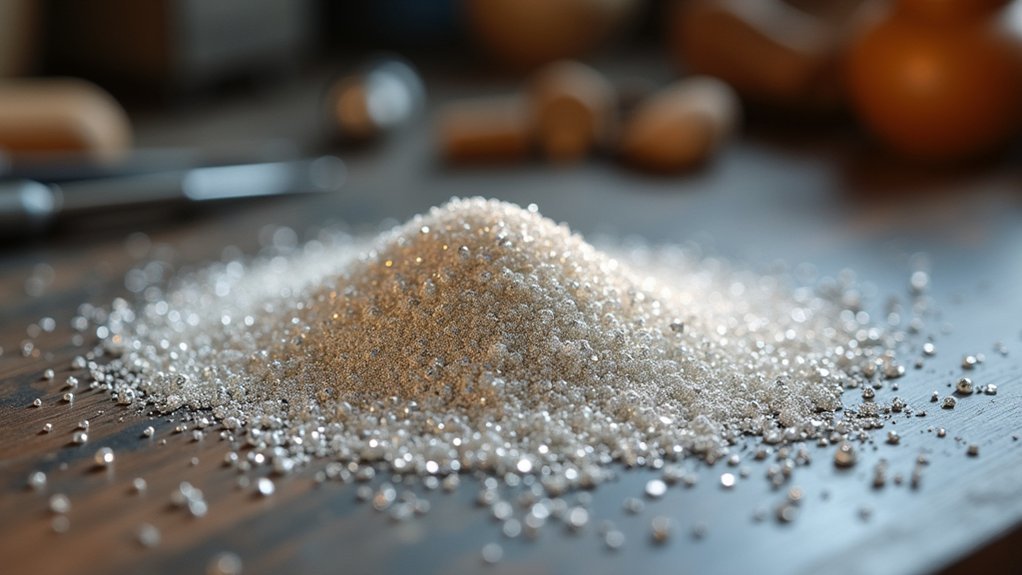You’ll master artisan sand casting through nine essential techniques that deliver exceptional results. Green sand molding captures intricate jewelry details affordably, while shell molding creates smooth pendant surfaces with minimal finishing. Lost PLA casting with 3D printed patterns opens new design possibilities, and two-part molds handle complex ring geometries. Flat back casting streamlines medallion production, investment casting perfects precious metals, and vacuum-assisted methods eliminate defects. Multi-level techniques create layered elements, while pattern modifications enable custom variations that’ll elevate your metalwork to professional standards.
Green Sand Molding for Delicate Jewelry Components

When you’re crafting delicate jewelry components, green sand molding offers an exceptional balance of affordability and precision that’s hard to match with other casting techniques.
This versatile mixture of silica sand, clay, and water packs easily around detailed patterns, capturing intricate designs with remarkable accuracy. You’ll find it works perfectly with both ferrous and non-ferrous metals, making gold, silver, and bronze pieces achievable.
However, you must monitor moisture levels carefully—sand that’s too wet or dry will compromise mold integrity and affect casting quality.
Proper moisture control in green sand molding is critical—incorrect levels will destroy mold stability and ruin your casting results.
The sand’s flexibility guarantees fine details transfer beautifully to your final piece. Remember that finishing processes like polishing are essential for achieving professional results, transforming your raw castings into stunning delicate jewelry with exceptional shine and detail.
Shell Molding Technique for High-Detail Pendant Creation
You’ll find that shell mold preparation requires heating your pattern and applying a sand-resin mixture that cures into a rigid shell around it.
The technique’s fine sand composition allows you to capture intricate pendant details with exceptional surface smoothness.
Once you’ve completed the casting process, you’ll need minimal finishing work since shell molding naturally produces high-quality surface textures on your pendants.
Shell Mold Preparation
Although traditional sand casting works well for basic shapes, shell molding transforms pendant creation by delivering exceptional detail and precision that artisans demand.
You’ll start by heating your pattern to approximately 400-500°F, then coating it with a resin-bonded sand mixture. The heated pattern causes the resin to cure rapidly, forming a thin, durable shell mold around your design.
You’ll achieve superior dimensional accuracy and surface finish compared to conventional methods. The shell mold captures intricate details that would challenge other techniques, enabling high-quality production with minimal post-processing.
This rapid process reduces common defects like porosity while maintaining tight tolerances. As an artisan, you’ll appreciate how shell molding delivers consistent results, allowing you to focus on design creativity rather than extensive finishing work.
Pendant Detail Finishing
Shell molding’s superior surface quality sets the foundation for exceptional pendant finishing results.
When you complete your sand casting process using shell molds, you’ll notice the smooth surface requires minimal post-casting work compared to traditional methods. The intricate designs emerge with sharp definition, eliminating extensive grinding or filing that typically plagues other casting techniques.
You’ll achieve high-quality castings that need only light polishing compounds to bring out the metal’s natural luster.
Focus your detail finishing efforts on enhancing the pendant’s aesthetic appeal rather than correcting surface imperfections. The precise edges and clean lines produced by shell molding allow you to create professional-grade artisan jewelry that showcases complex patterns and fine textures, giving your metal objects a refined, polished appearance.
Lost PLA Casting With 3D Printed Patterns

You’ll start your lost PLA casting by designing a 3D pattern that accounts for metal shrinkage and includes proper draft angles for clean burnout.
Your PLA pattern must be printed with sufficient wall thickness to prevent cracking during handling while maintaining the fine details you want in your final cast piece.
You’ll need to control the burnout temperature carefully, heating your mold gradually to around 400°F to guarantee complete PLA removal without damaging the sand cavity.
3D Pattern Design Process
When you combine modern 3D printing technology with traditional sand casting methods, the D pattern design process opens up new possibilities for creating intricate metal objects that would be difficult or impossible to achieve through conventional pattern-making techniques.
Your 3D printed pattern serves as the foundation for creating detailed artisan pieces. You’ll pack the PLA pattern in sand to form your sand mold, then heat it to 400°F to melt away the material cleanly. This leaves a precise cavity for pouring molten metal.
| Process Step | Temperature | Key Consideration |
|---|---|---|
| Pattern Creation | Room Temp | Design complexity limits |
| Mold Packing | Room Temp | Sand compaction quality |
| PLA Removal | 400°F | Complete pattern elimination |
| Metal Pouring | Variable | Sprue placement optimization |
| Cooling Phase | Gradual | Prevent casting defects |
Strategic sprue placement guarantees proper metal flow throughout your sand mold, enabling successful reproduction of complex shapes during the casting process.
PLA Burnout Temperature Control
Achieving proper burnout temperature control determines whether your lost PLA casting succeeds or fails completely.
You’ll need to heat your sand casting mold to 350°F-400°F for complete pattern removal. Don’t rush this burnout process—gradually increase temperature to prevent thermal shock that’ll crack your mold and destroy hours of work.
Maintain proper ventilation since PLA releases harmful fumes during heating. Hold your target temperature for 4-6 hours, ensuring every trace of plastic vaporizes. This dwell time protects mold integrity while guaranteeing clean cavities for your artisan pieces.
Consider two-part molds for better containment during burnout. Master these casting techniques, and you’ll consistently produce flawless results without the frustration of failed pours or damaged patterns.
Two-Part Mold Construction for Complex Ring Designs
Although single-piece molds work well for simple shapes, complex ring designs with intricate details or undercuts require a two-part mold construction approach that allows you to capture every nuance of your pattern.
Start with a durable metal or high-quality plastic pattern to maintain dimensional accuracy throughout the sand casting process. Pack sand tightly around the first half in your mold frame, eliminating air pockets that could compromise detail reproduction.
Essential steps for success:
- Create the sprue channel – Your lifeline for molten metal flow into internal cavities
- Align the two halves precisely – Misalignment destroys even the most careful preparation
- Pour with confidence – Fill the cavity completely through your sprue system
- Control cooling rates – Even temperature distribution prevents warping and shrinkage defects
This methodical approach guarantees your complex designs translate perfectly from pattern to finished piece.
Flat Back Sand Casting for Medallions and Coins

Flat back sand casting transforms medallion and coin production into a streamlined process that delivers professional results with minimal complexity. You’ll find this technique particularly valuable when creating decorative items that require uniform thickness and precise dimensions. The single-piece pattern eliminates alignment issues while delivering high accuracy in your final products.
| Advantage | Medallions | Coins |
|---|---|---|
| Setup Time | Faster production runs | Quick pattern changes |
| Detail Quality | Intricate designs possible | Sharp edge definition |
| Cost Factor | Low tooling investment | Minimal material waste |
This cost-effective method appeals to artisans seeking production efficiency without sacrificing quality. You’ll appreciate how the simplified process reduces complexity while maintaining the ability to create intricate designs. For small businesses, flat back sand casting offers an accessible entry point into professional medallion and coin production.
Core Making Methods for Hollow Jewelry Forms
Two distinct approaches define core making for hollow jewelry forms: creating cores separately before insertion or forming them directly within your mold cavity.
Core making enables you to craft internal shapes that transform ordinary artisan pieces into extraordinary hollow jewelry forms.
Core making transforms your ordinary jewelry designs into extraordinary hollow masterpieces through precise internal shaping techniques.
Your core sand mixture requires precise binder-to-sand ratio control to withstand the metal pouring process. Properly vented cores prevent devastating defects like blowholes that’ll ruin your masterpiece.
Core making reveals these creative possibilities:
- Delicate filigree patterns that’ll captivate admirers
- Multi-chambered pendants showcasing your technical mastery
- Lightweight statement pieces comfortable for extended wear
- Complex geometric forms impossible through solid casting
Master your core preparation, guarantee adequate venting, and you’ll consistently produce intricate designs that establish your reputation as a skilled artisan.
Investment Sand Casting for Precious Metal Pieces

When precision meets artistry in precious metal casting, investment sand casting emerges as your gateway to creating museum-quality jewelry pieces that’ll command premium prices.
This lost-wax technique transforms your wax models into stunning precious metals like gold, silver, and platinum through meticulous mold preparation using high-quality silica sand and specialized binder systems.
You’ll achieve intricate designs impossible with traditional casting methods, producing complex shapes with exceptional dimensional accuracy.
The jewelry industry favors this process because it delivers superior surface finish while minimizing post-casting work—crucial when working with valuable materials.
Your investment sand casting mold withstands extreme temperatures, ensuring every detail transfers perfectly to your final piece.
This technique creates lightweight yet durable components that enhance both aesthetic appeal and structural integrity.
Vacuum-Assisted Sand Casting for Superior Surface Finish
As you elevate your sand casting craft to professional standards, vacuum-assisted technology becomes your secret weapon for achieving flawless surface finish that rivals machine-produced components.
This advanced sand casting method removes air from your mold cavity, ensuring molten metal flows smoothly into intricate designs while eliminating porous defects that plague traditional techniques.
Your vacuum-assisted process delivers transformative benefits:
Vacuum-assisted sand casting transforms your metalworking with superior mechanical properties, exceptional surface quality, and enhanced productivity for complex geometries.
- Superior mechanical properties through reduced porosity and shrinkage defects
- Exceptional surface quality that minimizes post-casting finishing work
- Complex geometry capability for thin-walled, lightweight components
- Enhanced productivity with faster cycle times for scaled production
For artisan applications demanding precision, you’ll find vacuum-assisted sand casting eliminates common frustrations while maintaining the handcrafted character of your work.
This technology bridges traditional craftsmanship with modern efficiency.
Multi-Level Mold Techniques for Layered Jewelry Elements

While traditional single-level casting limits your creative possibilities, multi-level mold techniques reveal extraordinary potential for crafting sophisticated layered jewelry that showcases dimensional depth and intricate designs.
You’ll construct individual molds for each layer, then stack or assemble them to create cohesive pieces with enhanced visual impact.
When you employ split pattern or false cope techniques, you’ll produce hollow sections within your layered jewelry elements, achieving lightweight yet structurally sound results.
Incorporating cores into your sand casting process enables you to create internal features and innovative shapes that weren’t previously possible.
You can experiment with varying sand mixtures and binders across layers, allowing artisans to achieve different textures and finishes that dramatically enhance your jewelry’s overall aesthetic appeal and dimensional complexity.
Pattern Modification Methods for Custom Artisan Variations
Since every artisan seeks to create truly unique pieces, mastering pattern modification methods becomes vital for developing your signature style and achieving custom variations that set your work apart.
You’ll achieve dimensional accuracy and surface finish by implementing these important techniques:
- Scale your patterns to compensate for metal shrinkage during cooling, typically adjusting 1-2%.
- Select durable materials like aluminum or high-density plastic for consistent repeated casting.
- Create split patterns to form intricate features and complex internal geometries.
- Design cores for internal features using sand mixtures for functional voids.
Surface texturing transforms ordinary castings into extraordinary artisan pieces through engraving or natural material impressions.
These pattern modification methods guarantee each creation reflects your artistic vision while maintaining professional quality standards.
Frequently Asked Questions
What Are the Three Types of Sand Casting?
You’ll find three primary sand casting types: green sand casting using clay-water mixtures, dry sand casting with baked molds, and shell molding using resin-coated sand for precision work.
What Are the 4 Stages of Sand Casting?
You’ll follow four stages: pattern making where you create a replica, mold making by packing sand around it, melting and pouring molten metal, then cooling and shakeout to reveal your finished casting.
How Can I Improve My Sand Casting?
You’ll improve your sand casting by optimizing sand-to-binder ratios, using quality patterns, controlling pouring temperatures precisely, preparing molds thoroughly with coatings, and experimenting with different casting methods.
What Is the Primary Disadvantage of Sand Casting?
You’ll face casting defects as sand casting’s primary disadvantage. Shrinkage, porosity, and misruns can compromise your final product’s quality, requiring additional work to fix these issues that naturally occur during the cooling process.
In Summary
You’ve now explored nine powerful sand casting techniques that’ll transform your artisan jewelry making. Whether you’re working with delicate components or complex multi-level designs, these methods give you the precision and creativity you need. Start with green sand molding if you’re beginning, then advance to vacuum-assisted casting for premium finishes. Don’t forget to experiment with pattern modifications—they’re your key to creating truly unique, custom pieces that stand out.





Leave a Reply